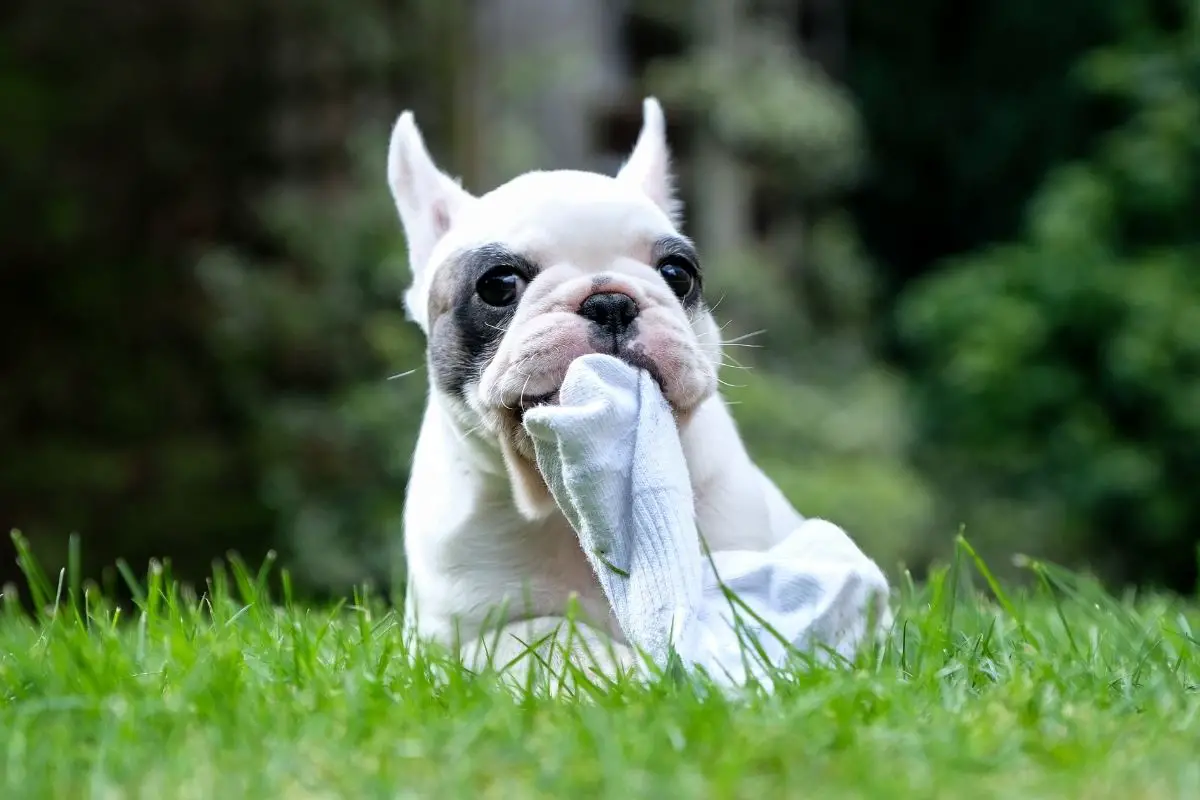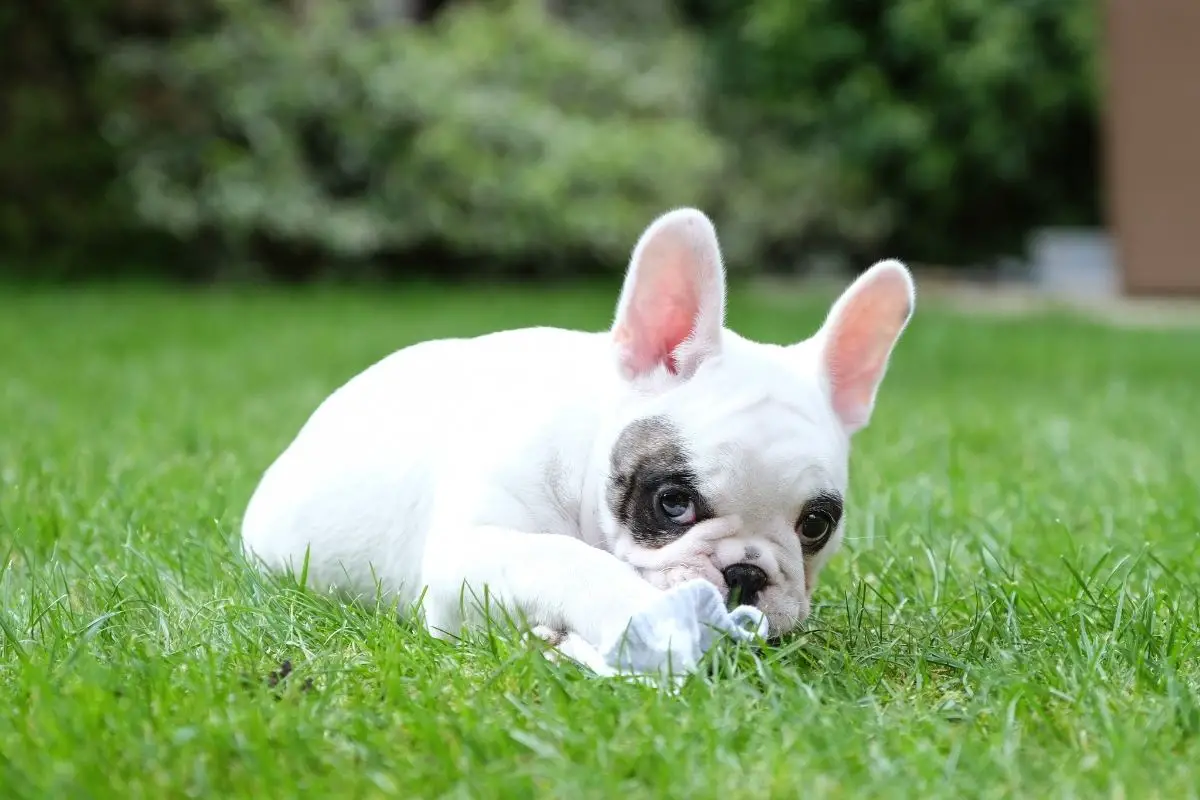The Pied French Bulldog is a type of French Bulldog that is known for its irregular patches.
If you’re looking to learn more about the Pied French Bulldog, you’ve come to the right place.
In this article, I will explore some key information about the Pied French Bulldog.
So, let’s get started.
Contents
What Is A Pied French Bulldog?
A Pied or Piebald French Bulldog is a small dog with short legs and large heads and typically weighing between 10 and 25 pounds.
They can be black, white, or brown in color. with a white coat that features large dark-colored patches on different parts of the body.
Piebald means to have irregular patches of two colors. Bearing this in mind, for a French Bulldog to be recognized as Pied, it must have a white coat with at least 50% spots or patches of black or another color on their body, head, and neck.
That being said, patches found on Pied French Bulldogs can be black, brown, or gray.
- Cream Pied French Bulldogs – These Frenchies have a cream coat that is spotted with fawn colored patches.
- Fawn Pied French Bulldogs – These French Bulldogs have white coats with fawn patches. Alternatively, they have a fawn coat that is spotted with black patches.
- Blue Pied Frenchies – These Frenchies have blue coats with patches of white or cream.
The Pied pattern is due to autosomal recessive inheritance, or in other words, a way a genetic trait is passed down from dog to dog.
Bearing this in mind, to get a Pied French Bulldog, therefore, you have to breed:
- Two Pied French Bulldogs
- Two solid-colored French Bulldogs (who are both carriers of the Pied gene)
- A Pied French Bulldog with a solid colored Frenchie (who is a carrier of the Pied gene)
If you’re thinking about getting one of these adorable dogs, here are some things that you should know before buying one.
Pied French Bulldog: An Overview

French Bulldogs were originally bred to hunt rats. Today, these dogs make adorable family pets.
With regard to a Pied French Bulldog’s personality, they are loyal, affectionate, and intelligent dogs.
They aren’t too energetic, making them ideal for a slower paced lifestyle. This means that if you don’t want to spend hours on end exercising your pooch, then they could be an ideal match for you.
They are great at socializing and are fine around children, and can easily live with other dogs no matter the breed, making them an ideal family pet.
They are very friendly and playful. They love to play fetch and also enjoy playing tug-of-war with their owners. That being said, they can get tired quite easily and benefit the most from short walks.
The pied French bulldogs have an average lifespan of 12 years, meaning they can provide ample years of companionship for you and your family.
Health Concerns
Like any other breed, there are health concerns associated with owning a Pied French Bulldog. Some of them include:
Brachycephalic Obstructive Airway Syndrome (BOAS)
BOAS is a condition that affects the breathing of dogs whose muzzle looks like it has been flattened or squashed inwards, making it harder for them to breathe.
Dogs with this condition struggle to regulate their temperature, which can cause them to overheat which leads to the next health problem.
Heat Exhaustion And Cold Intolerance
As they have trouble regulating their temperature, Frenchies can struggle with heat exhaustion.
To avoid this from happening, make sure that you walk them during cooler hours of the day, and avoid going outside when the sun is at its hottest.
In addition to this, they can also get very cold, so making sure that they have a good quality winter jacket is important.
Eye Problems
The most common eye problem among Pied French Bulldogs is cataracts. It affects both eyes, eventually making their eyes worse as it progresses.
Hip Dysplasia
Hip dysplasia is when the hip joint doesn’t fit properly into its socket. It causes pain and arthritis later in life.
Obesity
Frenchies have a heavy bone structure, which means even a small amount of weight gain can be problematic for their health and increases the risk of obesity.
Cardiac Disease
Heart problems are common among French Bulldogs, meaning it’s essential you keep them at a healthy weight.
Enlarged Heart
Another condition that is common is an enlarged heart. If your dog has an enlarged heart he may not live as long as his normal size counterparts.
Urinary Tract Diseases
Urinary tract diseases such as cystitis and pyelonephritis are common among French Bulldogs because they don’t drink enough water.
Skin Conditions
Skin issues such as dermatitis and allergies are common among French Bulldogs due to their thick fur, as well as the skin folds on their body.
Grooming Requirements

Pied French Bulldogs shed an average amount, and are relatively low maintenance to groom as all they need is an occasional brush.
This will help to remove loose hair and distribute natural oils evenly, helping to keep their coat healthy.
During the summer months, you will likely find that you need to up their brushing routine to once a week, as this is when they are likely to shed more often.
When you are bathing your French Bulldog, it’s important to keep shampoo away from their sensitive and delicate eyes. After washing, each of their skinfolds should be dried carefully.
To prevent infection, you should also clean their ears.
As French Bulldogs don’t tend to be as active as other dog breeds, their nails tend to become uncomfortably long and will therefore require to be trimmed regularly.
Exercise Needs
Exercise needs vary from breed to breed. As mentioned earlier, French Bulldogs can be playful and love playing games with their owners, however, they are considered to be ‘low energy’ breeds, so they don’t need a lot of exercise.
As a result, your Pied French Bulldog will need a minimum of 60 minutes of exercise every day. However, as they have flat faces, Frenchies can have severe breathing problems.
As a result, short, low-intensity walks that are distributed throughout the day are the best.
In addition to this, they need plenty of room to run around and burn off their energy throughout the day.
Price
The price of a French Bulldog can vary depending on the coat color, the breeder, as well as breeding lines. That being said, you can expect to pay between $1500 and $3000 for your Pied French Bulldog.
It is essential that you extensively research and buy your Pied French Bulldog from a responsible breeder. A good way of ensuring this is to find one who is registered by a Kennel Club.
More and more puppy farms are cropping up, and you should make sure that you’re looking at more than just one breeder.
Unlike dubious breeders, registered breeders make it their responsibility to follow ethical guidelines when breeding puppies.
Never be afraid to ask questions when you visit the breeder. If they seem suspicious or are dodging your questions and requests, then it’s likely you won’t want anything to do with them.
It’s also important to recognize that if something feels off, it probably is.
For instance, if they refuse to let you see the puppy’s mother, or insist on keeping the conditions in which the pups were bred under wraps, you should know better than to trust them.
Training Needs
French Bulldogs are intelligent, making them very adaptable when it comes to training.
They will love their training as long as you make it fun and keep the sessions short, as this breed adores playing games.
They will happily learn all the training basics and as well as some tricks provided that you are consistent with teaching them.
Below are some training tips to bear in mind when you’re training your Pied French Bulldog.
Training Tips To Consider When Training A Pied French Bulldog

Training tips for Pied French Bulldogs include but are not limited to:
1. Beginning Training Early
The sooner you start teaching your Pied French Bulldogs to obey commands, the easier it will be to train them.
- Start Small
Start out with simple commands like sit, stay, down, come, etc., and slowly work your way up to more complex commands such as fetch, heel, and shake.
- Practice Obedience Exercises
Practice obedience exercises every day to help teach your dog how to obey commands.
- Keep An Eye On Your Dog With Others
It’s important to keep an eye on your dog while he’s learning new behaviors, as you don’t want them picking up any bad habits from others that could counteract your training.
This could mean asking other family members to not feed them when they beg.
- Don’t Overdo It
Don’t push your dog too hard during his training sessions. Remember that they are still a pup, and they’ll require time to develop. After all, Rome wasn’t built in a day!
2. Use Positive Reinforcement Techniques
Use positive reinforcement techniques to encourage good behavior instead of punishing bad behavior.
- Reward Your Dog
It’s important to reward positive behavior so that your dog can recognize when they’ve done what you’ve asked of them.
It might sound simple, but they need an incentive to make that positive association!
They will slowly begin to associate the praise and treats that you provide them with this behavior, so be sure to reward your dog whenever he does what you’ve asked him to do.
- Don’t Punish Bad Behavior
Never use punishment to correct your dog. This can easily result in you breaking the trust and the bond between you and your dog that you’ve spent time developing.
They also won’t learn anything through fear and intimidation, so this is a counterproductive way of training them.
In the long run, it could result in you damaging your relationship with your dog and they won’t be any wiser for it, either.
Shock collars, and other means of correction are cruel, and there’s a reason why they’re banned in multiple countries.
Bearing this in mind, you should stick to positive reinforcement for the most effective training.
3. Socialize Your Dog From An Early Age
This might sound like an obvious one, but ensuring that your dog gets to socialize with other dogs and interact with other people is fundamental to their development.
If you don’t expose your dog to different situations and environments such as the park and doggy day care, you could end up with a dog who doesn’t enjoy interacting and could even be anxious and fearful to interact with other animals and humans.
Exposing them to new and exciting situations when they’re a puppy is a good way of counteracting this anxiety.
However, you will want to make sure that they feel safe and supported whilst doing so.
4. Remain Consistent With Their Training
While it might feel frustrating to you to have to do the same training over and over again, this is the only way to ensure that it becomes second nature to your dog.
You can’t expect a puppy to get their training exercises overnight! It requires time and dedication to the cause.
This means that you need to be training them consistently in short bursts to ensure that you have their full concentration.
Training your dog in short bursts will also reduce the amount that they get confused, and is actually much more beneficial to their progress in the long run.
Bearing this in mind, it’s important to recognize when it’s time to leave it for the day.
Are Pied French Bulldogs Rare?
Yes, Pied French Bulldogs are relatively rare. However, they aren’t as rare as Blue Merle Frenchies, as this is the rarest color that exists in this particular breed.
In Summary
Hopefully, after reading this article you have a better understanding of Pied French Bulldogs. If you want to learn more about Bulldogs, Check our our Bulldog Section.
Make sure that you research the breeders that you’re interested in, and always visit them at home to ask your questions.
Good luck finding your Frenchie!



![9 Types of Bulldogs [All You Need to Know]](https://www.animalfate.com/wp-content/uploads/2021/01/Types-of-Bulldogs-211x150.jpg)